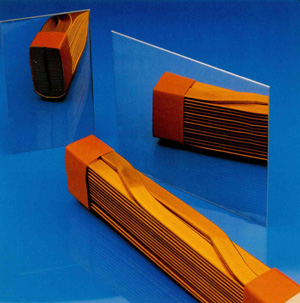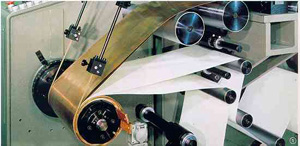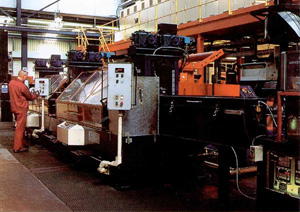Transformer Innovations
Copper Applications in Electrical Technology
Copper is a key component of the power transformers used to transport electricity from power stations to end-users, such as industry, commercial offices and homes. Transformers have a long life span, up to 40 years, and must operate reliably and efficiently, often outdoors in all weathers. Although they have no moving parts, they are subject to considerable mechanical and electrical stresses.
High conductivity copper and special magnetic steels, are used to construct the coils and core within the transformer which raise or lower the power network voltages. The internal connections and external terminations are also fabricated from copper. In Europe alone, several million tonnes of copper are installed in working power transformers.
Transformer coils are wound from copper conductors, mainly in the form of round wire and rectangular strip. The efficiency of a transformer is crucially dependent on copper purity and the way in which the coils are assembled and packed into it. Coils should be arranged to minimize wasteful induced currents. The empty space around and between the conductors also needs to be reduced to as small as possible.
Although high purity copper has been available for many years, a series of recent innovations in the way in which copper is fabricated have greatly improved transformer design, manufacturing processes and performance.
The copper wires and strip for transformer manufacture are produced from wire-rod, a basic semi-fabrication now obtained by the high-speed continuous casting and rolling of molten copper. Continuous processing, combined with new handling techniques, has enabled suppliers to offer wire and strip in much longer lengths than was previously possible. This has allowed automation to be introduced to transformer manufacture, and eliminated the welded joints which in the past occasionally contributed to shortened transformer lifetimes.
 Continuously Transposed Conductor
Continuously Transposed Conductor © Lacroix & Kress GmbH
An ingenious way of minimizing losses through induced currents is to rotate the conductors within the coil, in such a way that continuous close contact between adjacent strips is avoided. This is difficult and expensive for the transformer manufacturer to achieve on a small scale in building individual transformers, but copper semi-fabricators have developed a product, continuously transposed conductor (CTC), which can be supplied directly to the factory.
CTC provides a ready-insulated and tightly packed array of conductors for building transformer coils. The packing and transposition of individual conductors is undertaken on specially-designed in-line machinery. Copper strips are taken from a large drum-twister, which is capable of handling 20 or more separate reels of strip. The head of the machine stacks the strips into piles, two-deep and up to 42 high, and continuously transposes the top and bottom strips to minimize conductor contact.
The copper wires and strips used for transformer manufacture are insulated with a coating of thermosetting enamel, paper or synthetic materials. It is important that the insulation material is as thin and as efficient as possible to avoid unnecessary waste of space. Although the voltages handled by a power transformer are high, the voltage differences between neighboring layers in the coil can be quite low.
 Rolling Wide Transformer Sheet
Rolling Wide Transformer Sheet © Wieland-Werke AG
Another innovation in the fabrication of compact low-voltage coils in smaller distribution transformers is the use of wide copper sheet, rather than wire, as a raw material. Sheet production is a demanding process, requiring large, very accurate machines to roll sheet up to 800mm wide, between 0.05-3mm thick, and with a high quality surface and edge finishing.
Because of the need to calculate the number of turns in a transformer coil, and match this to the transformer dimensions and the current which the coil must carry, transformer manufacturers have always demanded a wide range of sizes of copper wire and strip. Until recently this was a challenging problem for the copper semi-fabricator. He had to carry an large range of dies to draw strip to the required size. The transformer manufacturer requires quick deliveries, often of quite small tonnages, but no two orders are the same, and it is uneconomic to keep finished material in stock.
 Cold Rolling of Transformer Strip
Cold Rolling of Transformer Strip © Essex International
New technology is now being used to produce transformer strip by the cold rolling of copper wire-rod to the required size, rather than drawing it down through dies. Wire-rod in sizes up to 25mm is rolled in-line to dimensions ranging between 2x1mm and 25x3mm. A wide variety of edge profiles, to improve technical performance and prevent damage to insulating materials, is provided by computer controlled forming rolls. A rapid delivery service can be offered to transformer manufacturers, and there is no longer the need to carry a large stock of dies, or replace worn dies.
Monitoring and quality control is undertaken in-line, using technology which was originally developed for the high-volume rolling of metals. Copper producers and semi-fabricators are continuing to develop new products and services to improve transformer efficiency and reliability. These include temper, consistency of tensile strength, surface quality and appearance. They are also working in areas including copper purity and enamel insulating systems. Sometimes innovations developed for other end-markets, such as electronics lead frames or aerospace, are adapted for transformer manufacture.
Also in this Issue:
- Transformer Innovations
- Copper Racing to Success
- Transformers Can Contribute to Global Warming Goals
- Copper Patents
